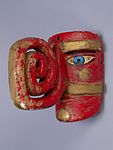Mask
About this object
History of use
This mask was used in the Dance of the Moors and the Christians which, along with other dance dramas, was introduced into Mexico by Franciscan missionaries as early as the sixteenth century as a mean of converting indigenous peoples to Christianity. Some of these dramas were already popular in parts of Europe: dances depicting Moors and Christians were performed in Aragon and Burgundy as early as the twelfth century, and spread south to Valencia and Murcia and west to Galicia and Portugal before converging in Castile in the fifteenth century. Many versions of this dance –some of which included dialogue that focused on the struggle between Christians led by Santiago, and the Moors– were adapted to represent the archetypal battle between Spanish Christianity and other “pagan” faiths. In most versions it is the Spanish who eventually win over the native population, whether they be Muslim or the indigenous peoples of the Americas. But in a few versions, such as the Dance of the Plumes, recorded in the valley of Oaxaca in central Mexico, and the Dance of the Tastoanes, in Jalisco, the victors are the indigenous protagonists. With God’s help, the indigenous peoples outwit the Spanish by killing Santiago, who is admonished by God in death for fighting on the side of the sinful Europeans. Santiago requests absolution and is resurrected, after which he leads the indigenous warriors to victory over their tormentors. Moor masks with spiral noses are called "Moro Pasion" (Suffering Moor), and were produced in Guerrero in the 1980s for the market, but they may be based on authentic masks from highland Puebla.
Physical description
Wooden mask painted red and gold. Red face with oversized protruding curled nose. The face has rectangular-shaped gold eyebrows, white eyes with blue pupils, black line markings around the eyebrows and eyes, gold circular designs on cheeks with black line markings around the perimeter, long rectangular-shaped gold moustache with black line markings around the perimeter, and small pink closed lips. A gold circular design is also found on the chin with black line markings around the perimeter.
